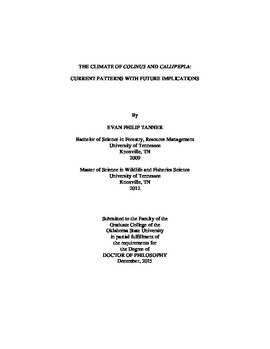| dc.contributor.advisor | Elmore, R. Dwayne | |
| dc.contributor.author | Tanner, Evan Philip | |
| dc.date.accessioned | 2016-09-29T18:46:32Z | |
| dc.date.available | 2016-09-29T18:46:32Z | |
| dc.date.issued | 2015-12 | |
| dc.identifier.uri | https://hdl.handle.net/11244/45380 | |
| dc.description.abstract | Climate change is a ubiquitous phenomenon that affects species at multiple spatial scales. Species' trends that are currently being observed may have future implications for conservation within the context of a dynamic climate. We monitored northern bobwhite (Colinus virginianus; here-after "bobwhite") and scaled quail (Callipepla squamata) space use and survival trends at a local scale, while also modeling the potential biogeographic responses of all temperate North American quail to predicted patterns of climate change. For instance, provision of artificial surface water during periods of extreme drought may not be warranted in future decades if water availability is decreased and if such provisions provide no benefit to species. Both bobwhite and scaled quail exhibited behavioral responses to the provision of anthropogenic surface water during periods of extreme drought by selecting for areas within 700 m of surface water. The probability of space use was greater in areas closer to water for bobwhite during the non-breeding season (beta = -0.06, SE = < 0.01) and for scaled quail during the breeding season (beta = -0.31, SE = 0.07). However, the presence of surface water sources did not influence survival or nesting success of bobwhite or scaled quail, thus this management practice is not supported. In general, all temperate North American quail are predicted to lose areas of environmental suitability except the Gambel's quail (Callipepla gambelii). Most species indicate a loss in southern latitudinal distributions. Bobwhite and scaled quail are predicted to lose areas of high relative abundance, where-as mountain quail (Oreortyx pictus) and California quail (Callipepla californica) are predicted to retain areas of high relative abundance. Local patterns of heterogeneity in thermal conditions may determine the magnitude of the responses of many of these species to climate change. We predicted that during periods of thermal extremes (<-15° C and >35°C), space use is least available for bobwhite. Furthermore, areas useable during the coldest thermal conditions are not similar to useable areas during periods of extreme heat events. These results further emphasize the need to understand local patterns and how they might affect regional responses in the context of climate change. | |
| dc.format | application/pdf | |
| dc.language | en_US | |
| dc.rights | Copyright is held by the author who has granted the Oklahoma State University Library the non-exclusive right to share this material in its institutional repository. Contact Digital Library Services at lib-dls@okstate.edu or 405-744-9161 for the permission policy on the use, reproduction or distribution of this material. | |
| dc.title | Climate of Colinus and Callipepla: Current patterns with future implications | |
| dc.contributor.committeeMember | Fuhlendorf, Samuel Dean | |
| dc.contributor.committeeMember | Davis, Craig A. | |
| dc.contributor.committeeMember | Baum, Kristen | |
| dc.contributor.committeeMember | Dahlgren, David | |
| osu.filename | Tanner_okstate_0664D_14318.pdf | |
| osu.accesstype | Open Access | |
| dc.type.genre | Dissertation | |
| dc.type.material | Text | |
| thesis.degree.discipline | Natural Resource Ecology and Management | |
| thesis.degree.grantor | Oklahoma State University | |
